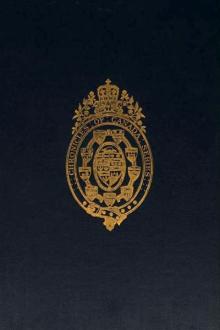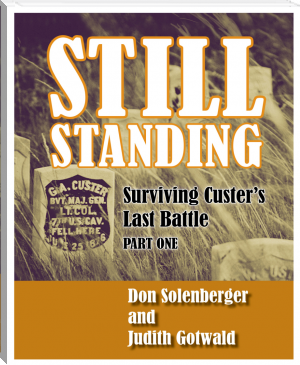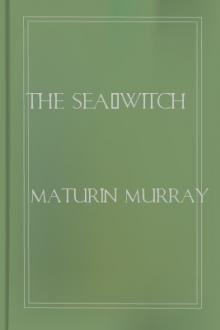The Mariner of St Malo by Stephen Leacock (early readers .TXT) 📕

- Author: Stephen Leacock
- Performer: -
Book online «The Mariner of St Malo by Stephen Leacock (early readers .TXT) 📕». Author Stephen Leacock
This position in itself, and the fact that at the time of his marriage in 1519 he had already the rank of master-pilot, would show that he had made the Atlantic voyage. There is some faint evidence that he had even been to Brazil, for in the account of his first recorded voyage he makes a comparison between the maize of Canada and that of South America; and in those days this would scarcely have occurred to a writer who had not seen both plants of which he spoke. ‘There groweth likewise,’ so runs the quaint translation that appears in Hakluyt’s ‘Voyages,’ ‘a kind of Millet as big as peason [i.e. peas]
like unto that which groweth in Bresil.’ And later on, in the account of his second voyage, he repeats the reference to Brazil; then ‘goodly and large fields’ which he saw on the present site of Montreal recall to him the millet fields of Brazil. It is possible, indeed, that not only had he been in Brazil, but that he had carried a native of that country to France. In a baptismal register of St Malo is recorded the christening, in 1528, of a certain ‘Catherine of Brezil,’ to whom Cartier’s wife stood godmother. We may, in fancy at least, suppose that this forlorn little savage with the regal title was a little girl whom the navigator, after the fashion of his day, had brought home as living evidence of the existence of the strange lands that he had seen.
Out of this background, then, of uncertainty and conjecture emerges, in 1534, Jacques Cartier, a master-pilot in the prime of life, now sworn to the service of His Most Christian Majesty Francis I of France, and about to undertake on behalf of his illustrious master a voyage to the New Land.
THE FIRST VOYAGE—NEWFOUNDLAND AND LABRADOR
It was on April 20, 1534, that Jacques Cartier sailed out of the port of St Malo on his first voyage in the service of Francis I. Before leaving their anchorage the commander, the sailing-masters, and the men took an oath, administered by Charles de Mouy, vice-admiral of France, that they would behave themselves truly and faithfully in the service of the Most Christian King. The company were borne in two ships, each of about sixty tons burden, and numbered in all sixty-one souls.
The passage across the ocean was pleasant. Fair winds, blowing fresh and strong from the east, carried the clumsy caravels westward on the foaming crests of the Atlantic surges. Within twenty days of their departure the icebound shores of Newfoundland rose before their eyes. Straight in front of them was Cape Bonavista, the ‘Cape of Happy Vision,’ already known and named by the fishermen-explorers, who had welcomed the sight of its projecting headlands after the weary leagues of unbroken sea. But approach to the shore was impossible. The whole coastline was blocked with the ‘great store of ice’ that lay against it. The ships ran southward and took shelter in a little haven about five leagues south of the cape, to which Cartier gave the name St Catherine’s Haven, either in fond remembrance of his wife, or, as is more probable, in recognition of the help and guidance of St Catherine, whose natal day, April 30, had fallen midway in his voyage. The harbourage is known to-day as Catalina, and lies distant, as the crow flies, about eighty miles north-westward of the present city of St John’s in Newfoundland. Here the mariners remained ten days, ‘looking for fair weather,’ and engaged in mending and ‘dressing’
their boats.
At this time, it must be remembered, the coast of Newfoundland was, in some degree, already known. Ships had frequently passed through the narrow passage of Belle Isle that separates Newfoundland from the coast of Labrador. Of the waters, however, that seemed to open up beyond, or of the exact relation of the Newfoundland coastline to the rest of the great continent nothing accurate was known. It might well be that the inner waters behind the inhospitable headlands of Belle Isle would prove the gateway to the great empires of the East.
Cartier’s business at any rate was to explore, to see all that could be seen, and to bring news of it to his royal master. This he set himself to do, with the persevering thoroughness that was the secret of his final success. He coasted along the shore from cape to cape and from island to island, sounding and charting as he went, noting the shelter for ships that might be found, and laying down the bearing of the compass from point to point. It was his intent, good pilot as he was, that those who sailed after him should find it easy to sail on these coasts.
From St Catherine’s Harbour the ships sailed on May 21
with a fine off-shore wind that made it easy to run on a course almost due north. As they advanced on this course the mainland sank again from sight, but presently they came to an island. It lay far out in the sea, and was surrounded by a great upheaval of jagged and broken ice.
On it and around it they saw so dense a mass of birds that no one, declares Cartier, could have believed it who had not seen it for himself. The birds were as large as jays, they were coloured black and white, and they could scarcely fly because of their small wings and their exceeding fatness. The modern enquirer will recognize, perhaps, the great auk which once abounded on the coast, but which is now extinct. The sailors killed large numbers of the birds, and filled two boats with them. Then the ships sailed on rejoicing from the Island of Birds with six barrels full of salted provisions added to their stores. Cartier’s Island of Birds is the Funk Island of our present maps.
The ships now headed west and north to come into touch with land again. To the great surprise of the company they presently met a huge polar bear swimming in the open sea, and evidently heading for the tempting shores of the Island of Birds. The bear was ‘as great as any cow and as white as a swan.’ The sailors lowered boats in pursuit, and captured ‘by main force’ the bear, which supplied a noble supper for the captors. ‘Its flesh,’
wrote Cartier, ‘was as good to eat as any heifer of two years.’
The explorers sailed on westward, changing their course gradually to the north to follow the broad curve of the Atlantic coast of Newfoundland. Jutting headlands and outlying capes must have alternately appeared and disappeared on the western horizon. May 24, found the navigators off the entrance of Belle Isle. After four hundred years of maritime progress, the passage of the narrow strait that separates Newfoundland from Labrador remains still rough and dangerous, even for the great steel ships of to-day. We can imagine how forbidding it must have looked to Cartier and his companions from the decks of their small storm-tossed caravels. Heavy gales from the west came roaring through the strait. Great quantities of floating ice ground to and fro under the wind and current. So stormy was the outlook that for the time being the passage seemed impossible. But Cartier was not to be baulked in his design. He cast anchor at the eastern mouth of the strait, in what is now the little harbour of Kirpon (Carpunt), and there day after day, stormbound by the inclement weather, he waited until June 9. Then at last he was able to depart, hoping, as he wrote, ‘with the help of God to sail farther.’
Having passed through the Strait of Belle Isle, Cartier crossed over to the northern coast. Two days of prosperous sailing with fair winds carried him far along the shore to a distance of more than a hundred miles west of the entrance of the Strait of Belle Isle. Whether he actually touched on his way at the island now known as Belle Isle is a matter of doubt. He passed an island which he named St Catherine, and which he warned all mariners to avoid because of dangerous shoals that lay about it. We find his track again with certainty when he reaches the shelter of the Port of Castles. The name was given to the anchorage by reason of the striking cliffs of basaltic rock, which here give to the shore something of the appearance of a fortress. The place still bears the name of Castle Bay.
Sailing on to the west, Cartier noted the glittering expanse of Blanc Sablon (White Sands), still known by the name received from these first explorers. On June 10
the ships dropped anchor in the harbour of Brest, which lies on the northern coast of the Gulf of St Lawrence among many little islands lining the shore. This anchorage seems to have been known already in Cartier’s time, and it became afterwards a famous place of gathering for the French fishermen. Later on in the sixteenth century a fort was erected there, and the winter settlement about it is said to have contained at one time as many as a thousand people. But its prosperity vanished later, and the fort had been abandoned before the great conflict had. begun between France and Great Britain for the possession of North America. Cartier secured wood and water at Brest. Leaving his ships there for the time being, he continued his westward exploration in his boats.
The careful pilot marked every striking feature of the coast, the bearing of the headlands and the configuration of the many islands which stud these rock-bound and inhospitable shores. He spent a night on one of these islands, and the men found great quantities of ducks’
eggs. The next day, still sailing to the west, he reached so fine an anchorage that he was induced to land and plant a cross there in honour of St Servan. Beyond this again was an island ‘round like an oven.’ Still farther on he found a great river, as he thought it, which came sweeping down from the highlands of the interior.
As the boats lay in the mouth of the river, there came bearing down upon them a great fishing ship which had sailed from the French port of La Rochelle, and was now seeking vainly for the anchorage of Brest. Cartier’s careful observations now bore fruit. He and his men went in their small boats to the fishing ship and gave the information needed for the navigation of the coast. The explorers still pressed on towards the west, till they reached a place which Cartier declared to be one of the finest harbours of the world, and which he called Jacques Cartier Harbour. This is probably the water now known as Cumberland Harbour. The forbidding aspect of the northern shore and the adverse winds induced Cartier to direct his course again towards the south, to the mainland, as he thought, but really to the island of Newfoundland; and so he now turned back with his boats to rejoin the ships. The company gathered safely again at Brest on Sunday, June 14, and Cartier caused a mass to be sung.
During the week spent in exploring the north shore, Cartier had not been very favourably impressed by the country. It seemed barren and inhospitable. It should not, he thought, be Called the New Land, but rather stones and wild crags and a place fit for wild beasts. The soil seemed worthless. ‘In all the north land,’ said he, ‘I did not see a cartload of good earth. To be short, I believe that this was the





Comments (0)